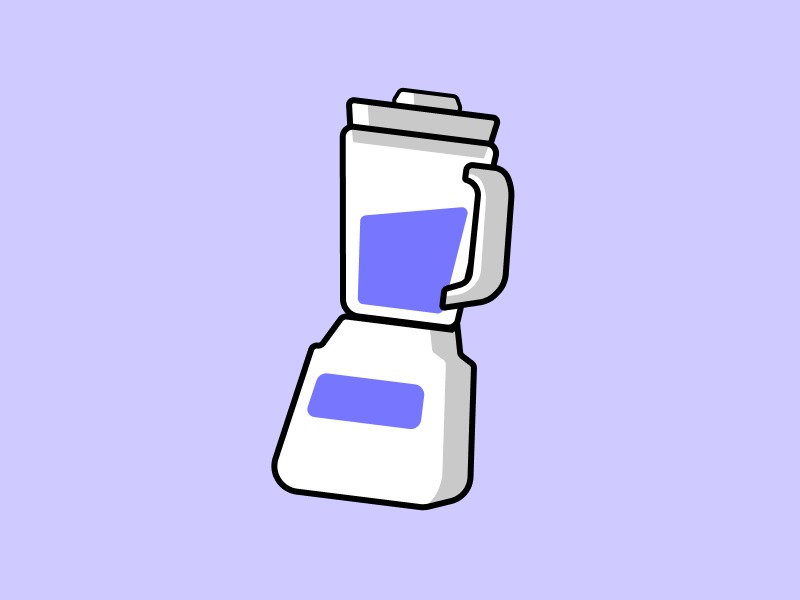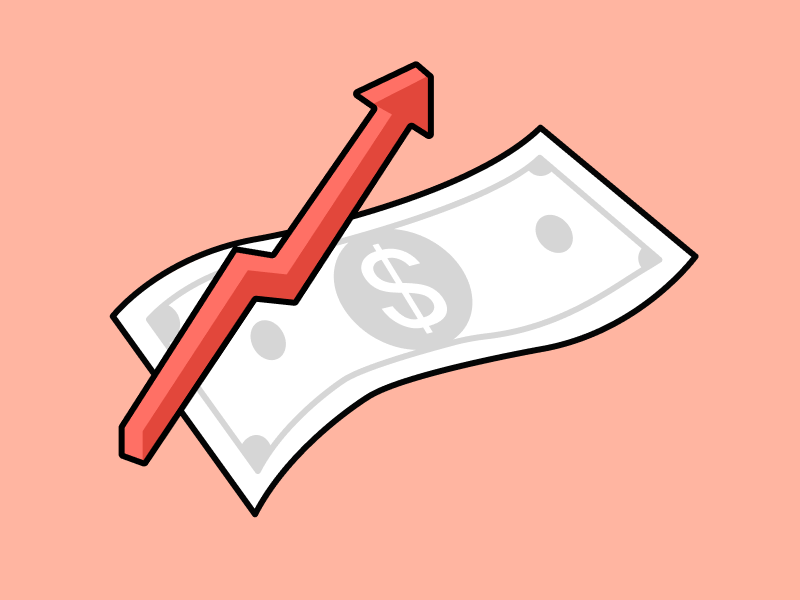What is Web 3.0?

The swift growth of crypto and blockchain technology has driven the development of Web3, which is often referred to as “the future of the internet.†Although the idea of Web 3.0 has been known for a while, it has only recently been applied in practical ways thanks to several crypto projects. So, what is Web 3.0? Why is it important and how can we use it? This article will explain Web3 in detail.
Article Summary
- 🌠Web3 is the third generation of the internet network where users, applications, and digital platforms are connected in a decentralized ecosystem. In this ecosystem, user interaction will rely on computer algorithms without the need for a third-party intermediary (trustless) and does not require permission from certain authorities (permissionless) so that user data is protected.
- 💻 What distinguishes it from the previous internet era, Web3 gives full authority to the individual who uses it. Unlike the current internet era or the era of Web 2.0, which is mostly run by big corporations like Google and Facebook. Web3 develops user engagement to have ownership of a particular part of the internet.
- 🔠The characteristics of Web3 are trustless and permissionless, self-governance, and data ownership. These four characteristics of Web3 play an important role in creating a secure decentralized ecosystem. It is also a Web3 solution to the problems we face today in Web 2.0.
What is Web 3.0?
Web 3.0 is the third generation of the internet network where users, applications, and platforms are connected in a decentralized ecosystem. The concept of Web 3.0 (also stylized as Web3) focuses on an internet ecosystem that is trustless and permissionless. In this ecosystem, user interactions will rely on computer algorithms without the need for a third-party intermediary (trustless) and do not require permission from certain authorities (permissionless) so that user data is protected.
Web3’s vision is to create a distributed and free internet network without a small subset of companies controlling the network. In addition, through cryptocurrencies and blockchain technology, Web3 also encourages users to participate in governing the network.
The Web3 ecosystem allows users not only to act as consumers but as shareholders and stakeholders in the platforms they choose.
Also read: What is Cryptocurrency and Blockchain?
Of course, the concept of web3 itself did not appear out of thin air, it is part of the development of the internet and technology. The first person to mention the concept of Web3 was Gavin Wood, the co-founder of Ethereum. Gavin said the principle behind Web3 is “less trust, more truth.†Gavin’s principle refers to Web3 which will release internet control from big companies like Google and Amazon and return it to users.
The concept of Web3 itself today still sounds abstract and difficult to understand. Therefore, in order for us to understand why Web3 is important and why we need it, we need to know the history of its development.
Evolution of the Internet and Web 3.0

Web 1.0 (1990-2004)
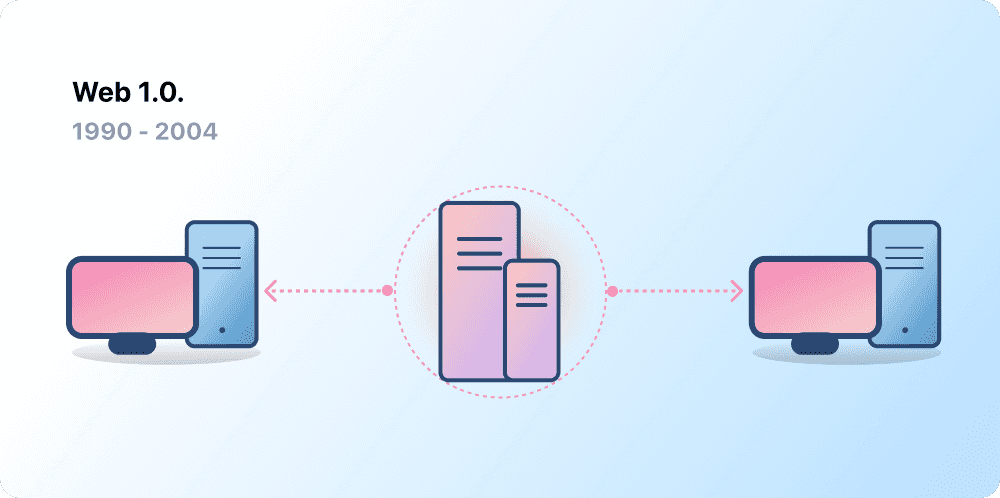
The concept of the internet was originally born as a US government project under the name ARPANET, or Advanced Research Projects Agency Network, in 1968. It is a small network that connects government agencies and professors at a number of universities such as MIT. Even so, the concept of world wide web itself was only born by a computer scientist named Tim Berners-Lee. The team wanted to create a protocol that would allow the movement of information from all parts of the world. However, as we know, this can only happen a decade later.
Web 1.0 mostly contains information created by several companies that users could then access. The interaction that can be done by internet users is very limited. Web 1.0 is still rigid, static, and contains read-only interactions. Most users in this era can only use the internet to read and find information. Companies dominated the early days of the internet for marketing their products.
However, Web 1.0 built an important foundation for the next Internet era.
Web 2.0 (2004-present)
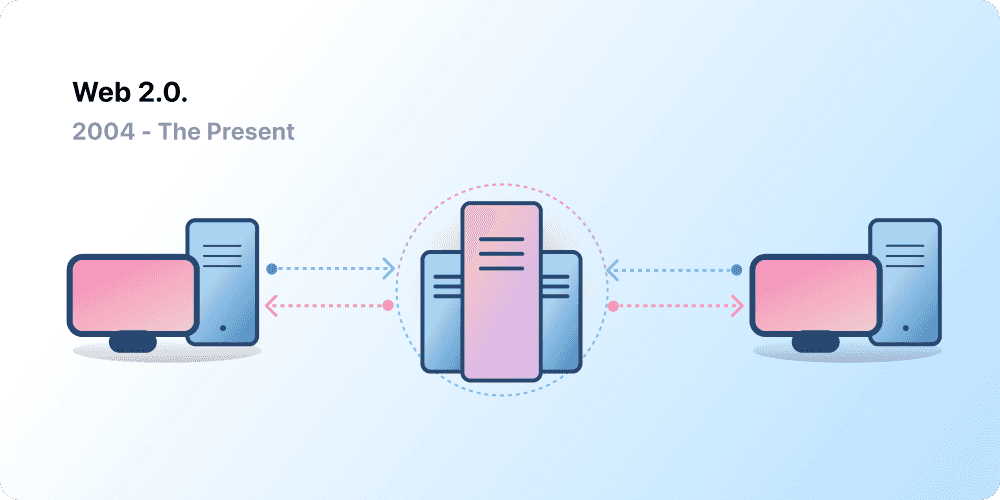
Web 2.0 was born with the advent of the social media era. Facebook and Myspace are two social media that started the era of social interaction in the digital space. Google, Napster, and Youtube then developed the concept of searching, creating, and sharing content for entertainment and information purposes. Web 2.0 creates multiple platforms where all users can create, read, and share all kinds of content with millions of people worldwide. This internet era enables social interaction between people across all parts of the world.
Naturally, this new era of the internet gave birth to a variety of new internet-based jobs and industries such as digital media, online marketplace, and content creation professions that we usually call influencers. The concept of user-generated content is the pillar that created Web 2.0 and is still relevant today.
However, Web 2.0 creates new problems. Even though the internet provides millions of sites that provide information, most people only use a few of the same sites. According to Semrush, the amount of traffic from Google, Amazon, Youtube, and Facebook sites exceeds that of all sites ranked 5-20 combined. Our internet is centralized in several companies that have a monopoly on content and access to information on the internet.

So, if we use the platform of a company like Google or Youtube then they have the right to access our personal data. We get to use their platform and they get our personal information. This becomes a problem when there are many cases of personal data being leaked, stolen, and hacked for criminal activities. Digital data protection has been the sole focus of governments across the world. In addition, platforms like Twitter have full control over blocking and closing content unilaterally.
This is exacerbated by the monetization of personal data for the benefit of the company (advertising) without requiring our consent as users. Twitter, Facebook, and Youtube also have prerogatives over the content we create on their sites. Even though some efforts have been made for users to control their data, unauthorized targeted ads still run wild without any means to control them.
So, in this era, big platforms like Google, Amazon, and Facebook ‘force’ us to trust them to secure and not misuse our personal data. Internet era Web 2.0 is built on the pillar of trust. As explained, trust is not a reliable pillar, especially as we’ve seen rampant misuse of personal data. Web3 is an attempt to move away from that pillar.
Web 3.0
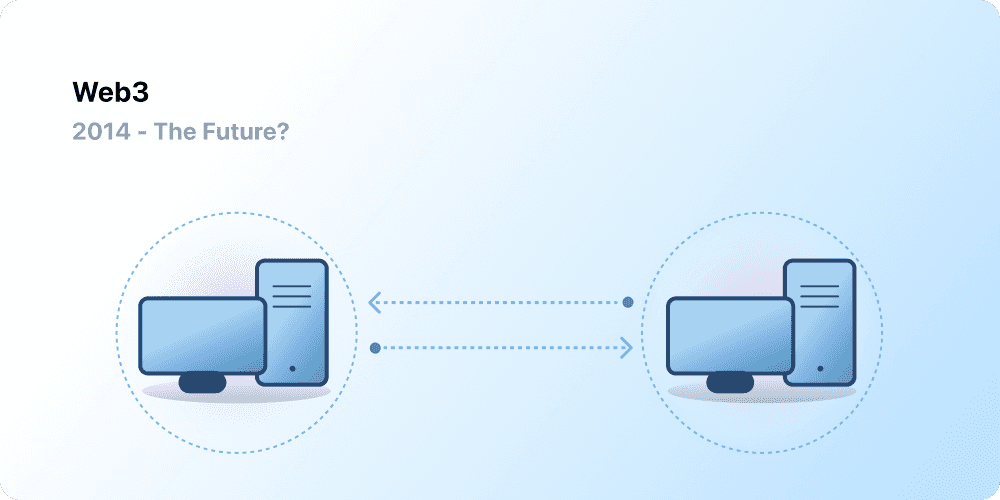
In 2008, Satoshi Nakamoto created a whitepaper on Bitcoin, an alternative payment system based on cryptographic code and blockchain technology. Bitcoin allows the creation of a decentralized payment system. Then, Vitalik Buterin and several other Ethereum founders created the technology that forms the foundation of Web3: smart contracts. Bitcoin and blockchain enable decentralized transactions and smart contract creates a decentralized network that is interconnected.
Blockchain technology and cryptography are changing the interaction between users and platforms providing services. In the era of Web 2.0, platform providers are responsible for being third parties that store personal data and funds owned by users. In the Web3 ecosystem, we don’t need to trust the platform to secure our data and funds because everything is regulated by algorithms and smart contract programs. We interact in a trustless manner.
Read also: Introduction to DApps and Smart Contract Technologies
Blockchain technology stores and manages all data on transactions that are both anonymous and transparent. The cryptocurrency cryptography process facilitates the security of the funds in every transaction. Everyone can directly transact with each other without any third party allowing and storing users’ personal data.
Application and platforms on the Web3 network have no control over their users and do not interact hierarchically. In the Web3 network, users and platforms have an equal position. This can happen because of the cryptocurrency that makes each owner shareholders of a platform. In addition, users not only become consumers and creators of the platform but can also participate in its regulation.
💡 A vivid example of this is tokens of several DEX (decentralized crypto exchanges) platforms such as UNI and CAKE where the holders can participate in various policies of their respective platforms. Some other crypto assets such as ApeCoin also have a decentralized management system through a DAO or Decentralized Autonomous Organization where all APE owners can participate in platform policies.
The Web3 era created a read-write-own interaction cycle as users own ownership of the assets of the Web3 network. Therefore, owning cryptocurrency is not only a sign of investing in assets but also acts as a token of governance and management of these assets.
Characteristics of Web3
Trustless and Permissionless
As already explained, the main characteristics of the Web3 internet era are trustless and permissionless. For most people, the impact of these two principles is invisible. The developments brought about by Web3 mostly happen behind the scenes, at the level of programming and code behind every application. The very first thing that users will notice when using a Web3 application is the use of crypto as currency in every transaction. They enable the global transfer of assets as applications on Web3 are connected to each other. Most Web3 platforms have interoperability with other platforms.
Self-governance
The Internet in the Web3 era is marked by the self-governance concept in which various platforms and applications implement the DAO system. The DAO system allows users to participate in determining platform policies. This self-governing model is an attempt by various Web3 platforms to decentralize and move away from the centralized model used by Amazon, Google, and other Web2.0 companies.
Data ownership
An important characteristic of the Web3 era is the existence of Data ownership. The Web 2.0 era is marked by large companies that have a monopoly on users’ personal data without any control to protect it. In fact, user data is treated like a commodity and ‘traded in’ for advertising purposes.
Blockchain technology and crypto enable anonymity when transacting by hiding users’ personal data behind encryption. With this, platforms, as well as companies on Web3, do not have access to their users’ personal data.
All of the above characteristics of Web3 represent efforts made to protect users and support a more democratic and open internet ecosystem.
Why is Web3 Important?
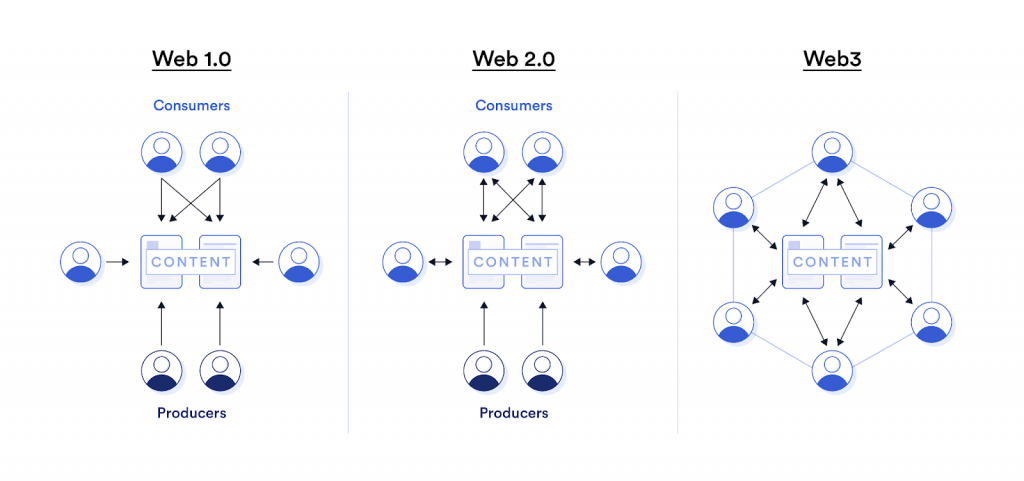
- 🡠Ownership: The Web3 Ecosystem ensures that everyone who participates has ownership of their own assets. All assets, data, and content owned on the Web3 platform are fully controlled by their creators. This can happen because it uses blockchain technology and cryptocurrency.
- 🌠Open-source: Web3 applications and platforms have an open-source programming language and application code that anyone can use and modify. In addition, applications on Web3 also do not control and limit user access.
- 💵 Payment System: The web3 internet economy runs on a cryptocurrency system. Crypto provides an alternative financial system based on blockchain and cryptography. This makes transactions via cryptocurrency decentralized, not controlled by third parties, and secure.
- 🕵ï¸â€â™‚ï¸ Control of Personal Data: Unlike in the Web 2.0 era, the Web3 era does not monetize its users’ personal data. Platforms and applications do not have access to or store the personal data of their users.
Weaknesses and Limitations of Web 3.0
Education and Understanding
The era of the Web3 internet brings with it many changes and different principles that many users may not recognize. Just like moving from the era of Web 1.0 to 2.0, this transition will take a long time. Web3 introduced principles, technologies, and interaction models that were very different from the internet we know today. Society needs time to process and understand these differences. In addition, as in the early days of the internet, many critics and experts are skeptical of this new era of technology and this is perfectly natural. Therefore, Web3 proponents and pioneers such as Ethereum and the Web3 Foundation are intensifying education about the new internet era.
User Experience
The majority of Web3 platforms and applications are still difficult to use for most people. Barriers to using these applications are still high because users need to understand a lot of technical terms. In the process of making transactions, users must understand crypto terms to avoid fraud and other criminal acts. Also, Some applications are also unintuitive and unnecessarily complicated for users. This prevents many Web3 platforms from being adopted by the mainstream.
Infrastructure
The Web 3.0 ecosystem is still in its infancy. Today, many Web3 platforms and applications still use a centralized Web 2.0 infrastructure (Google, AWS, Twitter, Discord). There is still a long way to go to create a fully decentralized Web3 infrastructure. However, we know that many new Web3 projects are working to fill this infrastructure gap such as Chainlink. The process of integrating a reliable and secure infrastructure will take a long time. This is still a weakness of Web3 that is often criticized by many experts.
Participation
The Web3 era focuses on the concept of decentralization in which users have an important role in the network. However, we need to ask how many people are willing and able to actively participate in helping the development of the platform? In addition to requiring an in-depth understanding of the platform, participating users need to spend time and effort. This is a unique aspect that can also be an obstacle because not everyone can and is willing to take the time to participate. As a result, a lack of participation can hinder the development of a platform.
Examples of Web 3.0 Platform in cryptocurrency
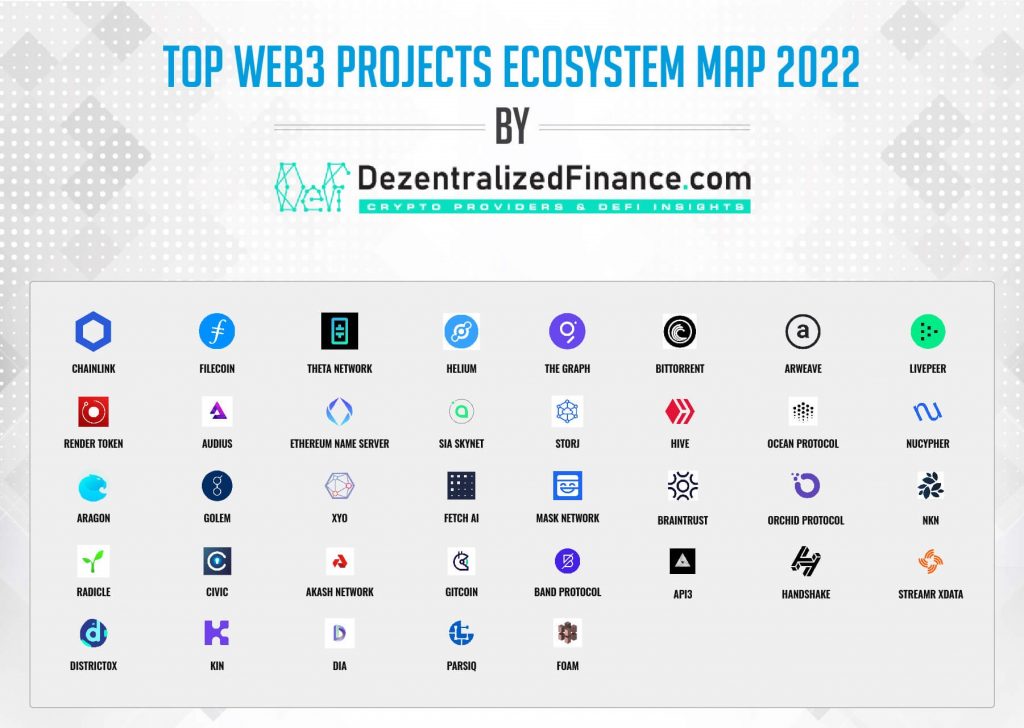
The influence of web 3.0 in the world of cryptocurrency and blockchain is very significant. These three things are closely related because crypto and blockchain can be the foundation for the development of Web3 and Web3 can increase the adoption of crypto in the long term. In fact, currently, there are various protocols and platforms in the cryptocurrency industry that we can categorize as part of the Web3 era. Some of these protocols share the previously described Web3 characteristics.
- 🌊 Ocean Protocol: The OCEAN Protocol is a blockchain network that allows businesses and individuals to exchange and monetize data. The Ocean Protocol provides a dataset tokenization service where data is converted into tokens called ‘datatokens’ and stored in the blockchain. Ocean Protocol is one of the Web3 platforms that have the potential to create a new data marketplace where researchers, businesses, and organizations have ownership over their own data.
- ï¸â›“ï¸ Chainlink: Chainlink is a decentralized blockchain oracle network that allows smart contracts to securely communicate with real-world data and services outside the blockchain network. Chainlink network is one of the important infrastructure projects because it is the bridge between Web 2.0 and Web3 data. Chainlink makes it easy for various Web 2.0 services to start moving to Web3.
- ï¸âš›ï¸ Helium Network: Helium Network is a blockchain network that provides hotspot services in a decentralized manner. Helium is a Web3 protocol that seeks to provide alternative internet services that are decentralized and utilize blockchain technology. The network utilizes the largest LoRaWAN network (internet service network similar to WiFi) in the world and provides Hotspot incentives in the form of HNT payments. Users can get Helium (HNT) tokens if they can provide a hotspot for the surrounding area. Helium also already supports 5G networks.
Read also: What is DeFi and How to Use It?
References
- Ethereum team, What is Web3 and why is it important?, Ethereum, accessed on 15 June 2022.
- Gilad Edelman, What Is Web3, Anyway?, Wired, accessed on 15 June 2022.
- Werner Vermaak, What Is Web 3.0? | Alexandria, Coin Market Cap, accessed on 16 June 2022.
- Chainlink team, What is Web3?, Chainlink, accessed on 16 June 2022
- Coin Telegraph writer, What is Web 3.0: A beginner’s guide to the decentralized internet of the future, Coin Telegraph, accessed on 17 June 2022.
- Kriptomat writer, What is Ocean Protocol? And how does OCEAN work? (2022 edition), Kriptomat, accessed on 21 June 2022.
- Coin Telegraph writer, What is Chainlink: A beginner’s guide to the cross-chain interoperability protocol, Coin Telegraph, accessed on 23 June 2022.
Share
